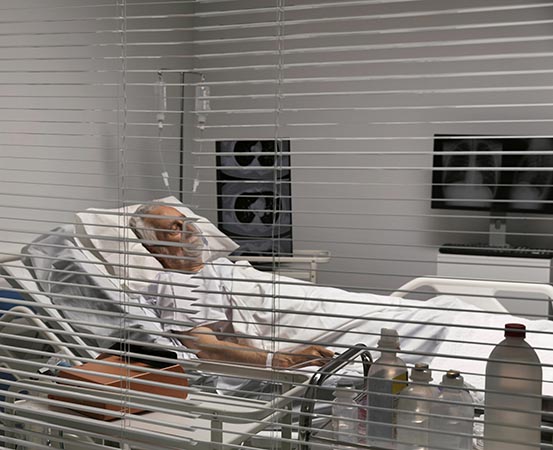In mid-2022, seventy-two-year-old Lalithambika, from Kollam, Kerala, had a fall at home which led to a hip fracture. She could not move and was bedridden. In two months, she developed bedsores. Many older adults like her end up with bedsores if confined to the bed for too long.
Constant pressure on weight-bearing body parts can result in skin peel and lead to deep ulceration, says Dr Shobha Subramanian-Itolikar, internal medicine, Fortis Hospital, Mulund, Mumbai. Bedsores, also known as decubitus ulcers or pressure ulcers are formed due to skin-fold compression.
READ MORE :
How to patch up that abnormal gait
Pacifying pain through palliative care
Managing delirium among elderly people
Malnutrition: how to spot the signs in older people
Bedsores: who is at risk
According to Dr Madhusudan G, senior plastic surgeon, Aster CMI Hospital, Bengaluru, those at high risk of bed sores include:
- People in chronic bedridden/immobile state
- Those with a loss of sensations below the waist due to spinal injury (paraplegia or leg paralysis)
- Those with hip and pelvis fractures
- Ones with severe malnutrition and weight loss
Commonly affected sites
Beena Krishnakumar, Lalithambika’s daughter, recalls that her mother became immobile post-fall and she developed bedsores despite using an airbed. The long duration of the bedridden state was the culprit. Wet skin due to perspiration or incontinence can cause bedsores.
Krishnakumar recalls that the sweating and compression caused bedsores on her mother’s neck, lateral breast region, back and tailbone consecutively.
Dr Madhusudan says that bedsores commonly affect the buttocks, sit bones (bottom part of the pelvis), hip, heel, tailbone and back of the head.
Dr Itolikar adds, “Bedsores on the buttocks are a common condition among elders who are bedridden.”
Progression of untreated bedsores in elderly
Bedsores, when left untreated, damage the skin. As per a research article published by the Indian Journal of Plastic Surgery, a stage-wise progression of bedsores is as follows:
Stage 1: Skin turns red, itchy, painful and warm around the sore.
Stage 2: Blisters and open wounds are formed.
Stage 3: Wound deepens causing liquid drainage.
Stage 4: Skin tissues die (tissue necrosis) causing excruciating pain, smelly liquid drainage, fever and chill in some cases.
Treatment of bedsores in older people
Dr Madhusudan explains that suitable dressings, frequently shifting the individual’s position, appropriate nutrients and supplements help cure the bedsores. “In extreme cases, we resort to surgery,” he says.
Dr Itolikar also emphasises that in worst cases, one can resort to skin grafting.
In Lalithambika’s case, the bedsores were identified in the early stages. “Anti-fungal ointment helped in cleansing and healing. Wet areas were pat dry with talcum powder. Extremely dry areas (such as back and tailbone) were moisturised with a petroleum jelly suggested by the doctors,” says her daughter.
According to Dr Santhosh Kumar J, professor, department of shalya tantra, Karnataka Ayurveda Medical College, Mangaluru, Ayurveda cleansing through specific herbal decoctions (kashaya) and healing through herbal oil application can help. “Avoiding food rich in carbohydrates (rice) speeds up healing,” he added.
Bedsores can be prevented
Bedsores can be largely avoided with airbeds, says Dr Madhusudan. Air beds, also called alpha beds are inflatable mattresses which are resilient to moisture, water and fire. “Airbeds not only prevent pressure on a single area but distribute it evenly,” says Dr Madhusudan. The airbeds are air-filled packets, which deflate and inflate pressure alternatively in adjacent areas. The usage of airbeds avoids consistent air pressure on weight-bearing areas of the body.
But using an airbed is not enough. Dr Madhusudan adds that the person must be repositioned and their pressure areas cleaned.
In the context of diapers, Dr Itolikar suggests that diapers should be changed every six hours. “One should opt for diapers made of organic materials (fibre/cotton), if available. If there are signs of skin-peeling on the buttocks, placing the buttocks on the swim rings (inflatable water doughnuts) can help heal [the skin].”
Takeaways
- Change the individual’s position at regular intervals
- Keep the pressure areas clean and dry. Provide bladder and bowel care to avoid urinary or faecal soiling of the area
- The skin should not be too dry or too moist
- Mild emollient creams cleanse bedsores and prevent dryness
- Talcum powders and absorbent bed surfaces and/or pads control moisture
- Airbeds are recommended



















4 Responses
Very informative content.Looking forward for more articles like this. Keep up the good work Deepali Mallya.?
Thank you so much for your positive response. Glad to know you liked our content.
Insightful article. Very well articulated. Thanks
Thanks a lot for your positive response. Delighted to know you liked the article.